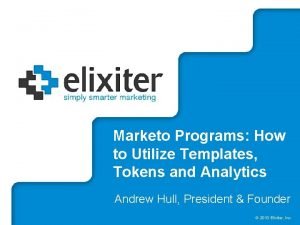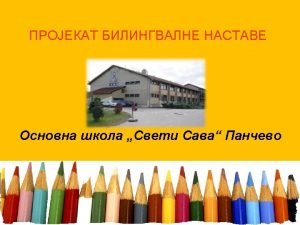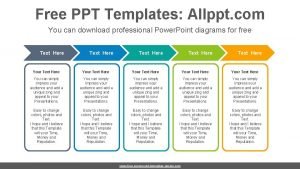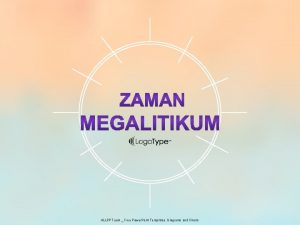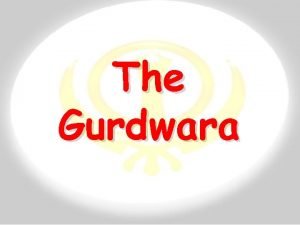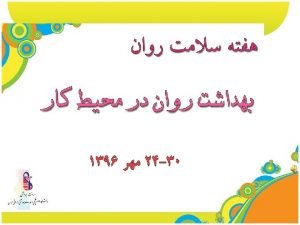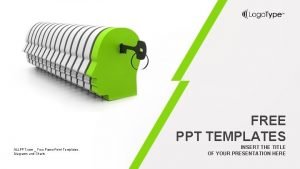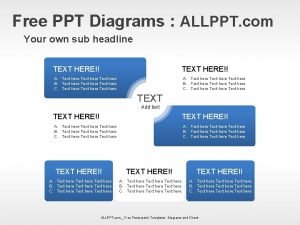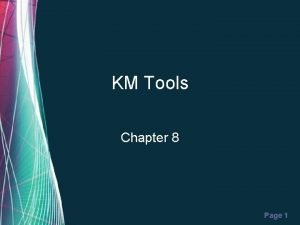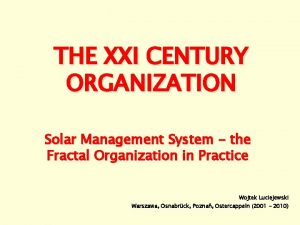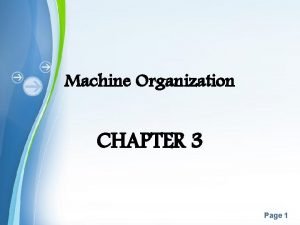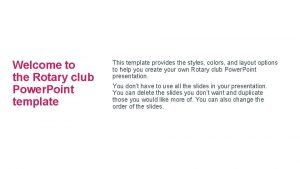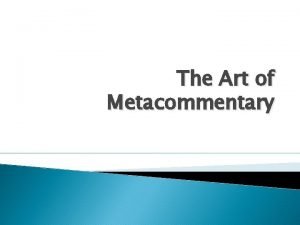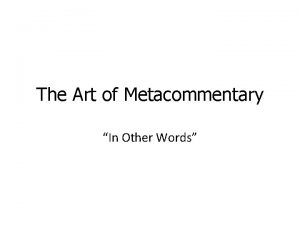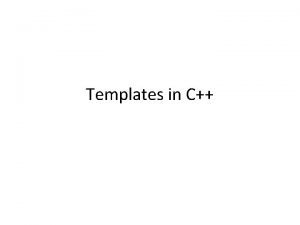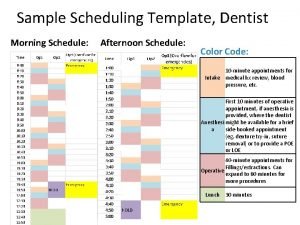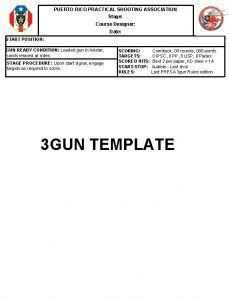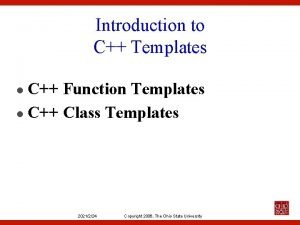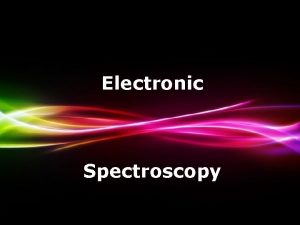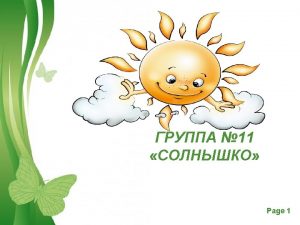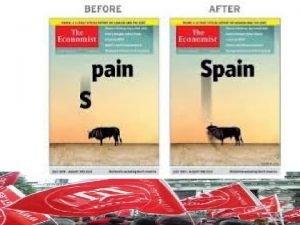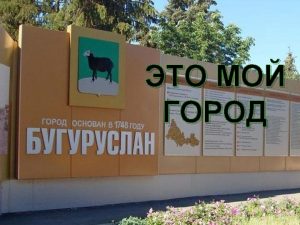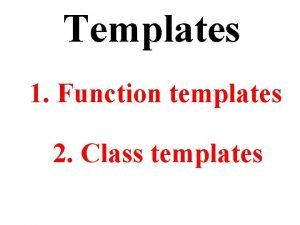Machine Organization CHAPTER 3 Powerpoint Templates Page 1







































- Slides: 39

Machine Organization CHAPTER 3 Powerpoint Templates Page 1

Lesson Outcomes CPU /Microprocessor architecture CPU processing methods Ø Pipelining Ø Superscalar Ø RISC Ø Multiprocessing v Instruction Cycle v Instruction Sets and Types v v Powerpoint Templates Page 2

CPU /MICROPROCESSOR ARCHITECTURE Powerpoint Templates Page 3

CPU/ Microprocessor Architecture Ø What is the central processing unit (CPU)? § It interprets and carries out the basic instructions that operate a computer. § contained on a single integrated circuit called a processor (micro) that is located on the motherboard. § contains two unit: Control Unit (CU) and Arithmetic Logic Unit (ALU). Powerpoint Templates Page 4

CPU/ Microprocessor Architecture • What is a microprocessor? – also called the CPU – A microprocessor or processor is the heart of the computer or any computing device – It is a semiconductor chip which can be programmed to do various functions and performs all the computational tasks, calculations and data processing etc. inside the computer. Powerpoint Templates Page 5

CPU/ Microprocessor Architecture – Today, there are several different manufactures of computer processors. However, Intel and AMD are the leaders in the PC market – Example of microprocessor are Intel Core i 7 -3770 K Quad-Core Processor, AMD FX-8120 8 -Core Powerpoint Templates Page 6

CPU Component • The processor contains four key components: Powerpoint Templates Page 7

CPU/ Microprocessor • The CPU deals with each instruction it is given in a series of steps. • Each step is repeated for each instruction. This series of steps is called the machine cycle. • machine cycle involves: – fetching an instruction from main memory – decoding the instruction (Translate the program instruction into the commands that computer can process) – executing the instruction (Carry out the commands one after another ) – Store the result into main memory Powerpoint Templates Page 8

CPU/ Microprocessor Powerpoint Templates Page 9

Control Unit (CU) • It works with the central processing unit (CPU) to instruct, maintain and control the flow of information. • CU is the “brain” of the microprocessor. • It contains all that the microprocessor microprograms • Microprogram is a set of microinstructions in a CPU, used to implement machine instructions. They reside in an internal ROM that cannot be accessed by the user. It contains the entire instruction set which are permanently embedded by the manufacturer). • CU will controls and interprets the execution of instructions, by following a sequence of actions that corresponds to fetch-execute instruction cycle Powerpoint Templates Page 10

Control Unit (CU) • To determine which instruction to be executed, CU reads the contents of the program counter (PC)/ instruction pointer (IP). • The instructions are then decoded by the Instruction Decoder in the CU. • Instructions are executed sequentially unless told otherwise • CU has a Memory Management Unit to supervise the fetching of instructions and data from memory. • The I/O interface is also part of the control unit. Powerpoint Templates Page 11

Control Unit (CU) • Instruction Decoder – Is properly part of the CU that decodes instructions that are sent to the microprocessor. – When an instruction is fetched from the memory, the instruction is then sent to the instruction decoder to be decoded or interpreted. Control signals will then be issued to perform the necessary operation. – The interpretation process is called instruction decoding. Powerpoint Templates Page 12

Arithmetic Logic Unit (ALU) • ALU is a digital circuit that performs many different arithmetic and logical operation on input data. It performs these operations as directed by the CU. • All computation performed by the microprocessor is done by the ALU • In short ALU performs : arithmetic operations such as addition and subtraction, division and multiplication all logic operations such as AND, OR, XOR etc Powerpoint Templates Page 13

Arithmetic Logic Unit (ALU) Four Components/ Structure on ALU: Comparator Shifter ALU Logic Register Control of ALU Powerpoint Templates Page 14

Component / Structure of ALU • Compares the magnitude of two numbers placed in buffer registers. The comparator, used in conjunction with Status Register, will output the results of the comparison. Comparator • Performs such logic operations as AND, OR, XOR, etc. Logic Register • provides input path for control signals and facilitate the sequencing and operation of each individual block of circuits. Control of ALU Shifter • move the contents of a register one or more positions left or right. Can also perform a unique operation called rotate when used with status register. Powerpoint Templates Page 15

Registers • A single, permanent storage location within the CPU used for particular defined purpose. • Used to hold binary value (shorten using Hexadecimal) temporarily for – Storage, – Manipulation, and/or – Simple calculations. • Register is the basic working components of the CPU. • Each register serves a particular purpose. Powerpoint Templates Page 16

Registers • A register may hold: data being processed instruction being executed memory or I/O address to accessed keeps track of the status of the computer or conditions of calculations Powerpoint Templates Page 17

Registers • Four primary operations by registers: Register can be Loaded with values from other locations (from other registers or memory location) Data from other location can be Added or subtracted Data can be Shifted or rotated right or left by one or more bits. Important in implementing of multiplication and division The value of data in register can be tested for certain conditions (zeros, negative, etc). Powerpoint Templates Page 18

Registers Control Unit contains several important register : - • Instruction Register (IR) – Holds the actual/current instruction being executed by computer. • Program Counter – Both a counter and a register. – The address in the program counter register is always the address of the next instruction to be executed. – The counter portion of the device generates sequential address numbers. Powerpoint Templates Page 19

Registers • Program Counter (cont) – When the current instruction is finished, It then increments, (adds 1 to the address) – It then generate and puts the number (new address) in the counter register (PC). – the program counter generates an address and places it on the address bus. – When the current instruction is finished, the above steps are repeated. – Thus, the program counter continually generates sequential address. Powerpoint Templates Page 20

Registers • Memory Address Register (MAR) – Holds the address of a memory location. • Memory Data Register (MDR) – Also known as Memory Buffer Register (MBR). – Holds data/instruction value that is being stored to or retrieved from the memory location currently addressed by the memory address register. Powerpoint Templates Page 21

Registers • Status Register (Flags) – Allow computers to keep track of special condition such as: Arithmetic carry, sign and overflow Power failure Internal computer error Powerpoint Templates Page 22

Registers • Status Register (Flags) - cont – The Status register contains individual flags (1 bit for each flag) – Status flags indicate the outcome of execution of arithmetic and logical operations – The control unit set (1) or reset (0) flags as a result of conditions that arise during the execution of instructions. Powerpoint Templates Page 23

System Clock • The system clock is a device that produces periodic sequence of pulses to control the timing of all computer operations. • These pulses define machine cycles. • During each machine cycle, some activity occurs, such as the execution of a micro-instruction. • The interval between corresponding edges of two consecutive pulses is called the clock cycle time. • The pace of the clock or the clock speed is measured by the number of cycles (ticks) per second. Powerpoint Templates Page 24

System Clock • Each tick is a clock cycle that determines when the next step in the machine cycle will occur – MHz – one million ticks per second of system clock theoretically, capable of executing one million instructions per second – GHz – one billion ticks per second of system clock • Therefore the faster the clock speed, the more instructions the processor can execute per second. • In some cases several instructions can be executed in a single clock tick. Powerpoint Templates Page 25

• an instruction is fetched by the Control Unit during instruction time (i-time) and executed by the ALU during execution time (etime) • together, both steps make up a single machine cycle & the process is repeated until the program is finished the clock drives • the clock drives the process by generating pulses at precisely timed intervals Powerpoint Templates Page 26

CPU PROCESSING METHODS Powerpoint Templates Page 27

CPU Processing Methods • In this topic, you will be introduced to the different and interrelated CPU processing methods. • The common goal is to increase the performance of the CPU. Among the methods are: – – Pipelining Superscalar CISC and RISC Multiprocessing Powerpoint Templates Page 28

CPU Processing Methods • Performance – number of instructions executed in a given amount of time. • To increase computer performance, these techniques are used: – Separating the fetch unit / execute unit • Allows independent, concurrent operation of the two units of the fetch-execute cycle – Overlapping between the fetch-execute cycles of sequences of instructions (pipelining) • This reduce the average time needed to complete an instruction. – Executing more than one instruction in a clock cycle (superscalar) Powerpoint Templates Page 29

CPU Processing Methods • Separating the fetch unit/ execute unit – Previously – instruction cycles are executed one by one. A new instruction enters the instruction cycle after the previous instruction has completed execution. – In the instruction cycle, two phases are involved – fetch phase and execute phase. – To increase performance, it is possible to separate the two phase and perform them concurrently. Powerpoint Templates Page 30

CPU Processing Methods • Fetch unit - retrieves and decodes the instructions – Fetches the instructions in parallel – Holds them in a buffer until it can be decoded and executed. – How many instructions in a buffer? • Size of instruction • Width of memory bus • Size of buffer Powerpoint Templates Page 31

CPU Processing Methods • Execute unit – performs actual instruction execution – Contains ALU and a portion of CU – Identifies and controls the steps that comprise the execution part of the instruction. Powerpoint Templates Page 32

CPU Processing Methods (pipelining) • Overlapping the instruction cycle of instructions. – fetch the next instruction while executing the current instruction. Powerpoint Templates Page 33

Concept of Pipelining • Laundry Example • Ann, Brian, Cathy, Dave each have one load of clothes to wash, dry, and fold • Washer takes 30 minutes A B C D • Dryer takes 40 minutes • “Folder” takes 20 minutes Powerpoint Templates Page 34

Without Pipeline Concept 6 PM 7 8 9 10 Midnight 11 Time 30 A B 40 20 30 40 20 • Sequential laundry takes 6 hours for 4 loads • If they learned pipelining, how long would laundry take? C D Powerpoint Templates Page 35

With Pipeline Concept 6 PM T a s k O r d e r 7 8 9 10 11 Midnight Time 30 A B C 40 40 20 • Pipelined laundry takes 3. 5 hours for 4 loads • Multiple tasks operating simultaneously using different resources D Powerpoint Templates Page 36

CPU Processing Methods Superscalar • Executing more than one instruction in a clock cycle. – Process more than one instruction per clock cycle – Instructions processed in parallel, with an average rate of more than 1 instruction per clock cycle through multiple execution units Powerpoint Templates Page 37

Superscalar Processing • Process more than one instruction per clock cycle • Separate fetch and execute cycles as much as possible • Buffers for fetch and decode phases • Parallel execution units Powerpoint Templates 8 -38 Page 38

Scalar vs. Superscalar Processing With pipelining Powerpoint Templates 8 -39 Page 39
 Marketo program templates
Marketo program templates High school graduation powerpoint template
High school graduation powerpoint template Allppt free templates
Allppt free templates Allppt free
Allppt free Free islamic powerpoint themes
Free islamic powerpoint themes Brainybetty
Brainybetty Free elearning templates for powerpoint
Free elearning templates for powerpoint Allppt.com free
Allppt.com free Powerpoint templates torrent
Powerpoint templates torrent Allpp
Allpp Are sikhs vegetarian
Are sikhs vegetarian Powerpoint templates
Powerpoint templates Usu powerpoint template
Usu powerpoint template Free real estate presentation templates
Free real estate presentation templates Allptt
Allptt Powerpoint templates free
Powerpoint templates free Http://www.free-powerpoint-templates-design.com
Http://www.free-powerpoint-templates-design.com Allppt.com _ free powerpoint
Allppt.com _ free powerpoint Apa introduction paragraph example
Apa introduction paragraph example Chapter 8 templates
Chapter 8 templates Process organization in computer organization
Process organization in computer organization Point to point organization
Point to point organization Tm pp
Tm pp Organization as a machine metaphor
Organization as a machine metaphor Sle155 chapter 3-4: img_2422
Sle155 chapter 3-4: img_2422 Finite state machine vending machine example
Finite state machine vending machine example Mealy or moore machine
Mealy or moore machine Moore machine to mealy machine
Moore machine to mealy machine Differentiate between simple machine and compound machine
Differentiate between simple machine and compound machine Rotary international powerpoint template
Rotary international powerpoint template Metacommentary exercise
Metacommentary exercise What is metacommentary example
What is metacommentary example Metacommentary example
Metacommentary example C generic programming
C generic programming Scentsy fundraiser ideas
Scentsy fundraiser ideas Dental scheduling templates
Dental scheduling templates Business review template
Business review template Ipsc stage design templates
Ipsc stage design templates Kpi meeting template
Kpi meeting template Templates in c++
Templates in c++
